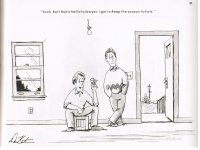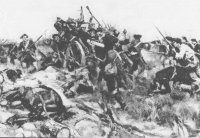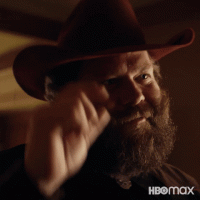OneManGang
Senior Member
- Joined
- Sep 7, 2004
- Messages
- 2,039
- Likes
- 9,675
Tennessee vs The Maxims vs Akron
DATE: 17 September 2022
PLACE: Neyland Stadium
ATTENDANCE: 101,915 (paid) actual in the mid- high 90s.
FINAL SCORE: Tennessee 63 Akron 6
We all know someone like this …

After the Vols' triumphant visit to the Steel City, the fans wanted to party and the hapless Akron Zips seemed the perfect foils for their revelry. So they turned out in huge numbers to cheer and celebrate. For their part, Akron did provide a bit of competition but at no point did they threaten to derail the party. The few folks wearing Akron colors were virtually all Mommas and Daddies and were outnumbered by the Pride. Indeed, for one of the few times I can recall, the Pride did not play the visitors' fight song during pregame. Although they have snubbed Vandy on occasion, particularly during the Doc Julian years.
Tennessee's first possession was lackluster. It was marked by a McGrtath field goal attempt that was hooked left and an injury to running back Jabari Smalls.
The Vol offense got on track and scored on their next two possessions.
End of 1st Quarter
Score: Tennessee 14 Akron 0
Tennessee picked up where it had left off scoring 21 unanswered points in the second. Akron showed a but of life and at one point drove down into scoring position. At that point they fumbled into the end zone where Latrell Bumphus recovered. On the ensuing Tennessee drive Herndon Hooker hit Jalen Hyatt for a 48-yard scoring pass.
End of 2nd Quarter
Score: Tennessee 35 Akron 0
Hooker stayed in for the opening UT drive of the second half and that was long enough for the Vols to score again. Akron drove to the Tennessee 17 aided by a spurious pass interference call and for some unfathomable reason, considering they were 42 points down kicked a field goal.
The Vols' next two possessions ended in punts but then Joe Milton found Ramel Keyton for a 47-yard TD.
End of 3rd Quarter
Score: Tennessee 49 Akron 3
Milton tossed another TD pass to Walker Merrill for 38 yards. The Zips answered with yet another field goal. Then freshman Tayven Jackson came in to bat clean-up. He promptly led a 75-yard scoring drive capped by a Manning-esque 1-yard run for a touchdown.
Final Score
Score: Tennessee 63 Akron 6
*******
On the 12th floor of the McClung Tower (that's the tall one next to HSS) there used to be a small lounge where you could get coffee and if you got there early enough, donuts and other pastries from the UT Bakery. As I recall it was all free but there may have been some nominal charge.
I discovered it because I had started UT early. I began the Summer Quarter of 1975 and so when Fall Quarter rolled around I was a seasoned veteran and snickered at all the incoming freshmen wandering around trying to figure out where everything was.
It was either the Winter Quarter or early in Spring Quarter when I declared my major. At that time the Liberal Arts admin was in Ayres Hall and when I went to the appropriate office, I told them I was thinking of majoring in History and minoring in Poli Sci. The lady looked up and said, “You know, you can major in both.”
Christmas had come early.
The neat thing about both majors was that the upper level courses, for the most part, did not have prerequisites. I immediately jumped into junior and senior level courses. One day after class one of the guys said, “Hey, let's go get some coffee.” Instead of heading to Smokey's Palace in the Student Center, we walked across to the tower elevators and went to that lounge. There was an unspoken agreement among those of us who knew of it to never speak of it lest the other 31,000 undergrads find out and storm the place.
There were comfy chairs and a couple of sofas. The windows provided a panoramic view of the southern part of campus and you could read, do homework or discuss various topics at you pleasure. The offices for the History Dept. and the Political Science Dept. were on the 11th and 10th floors respectively, so you could also pop down and talk to your profs as necessary.
One day several of us budding historians were up there when one of them asked me, “What do you know about the Battle of Guilford Courthouse?”
I pondered for a second and responded, “Well, since I've never heard of it, I assume we lost.”
He snickered and said, “Yes, and what a nice combination of insight and hubris you demonstrated.”
15 March 1781, Friends Meeting House, Deep River, North Carolina
Lt. Gen. Charles Cornwallis had been waiting for this day. For months he and the Continental forces under Gen. Nathaniel Greene had been circling each other. Cornwallis was confident his regulars could sweep Greene off the field, if he could just bring him to battle. For his part, Greene kept staying just out of the reach of Cornwallis and his army of just over 2,000. Now came word that Greene had encamped at a small hamlet called Guilford Courthouse about 10 miles away.
His army was more than ready for action. They were as frustrated as their commander at the slippery Americans refusing to stand and fight. Cornwallis knew in his heart that today would be long remembered. It would see the end of Greene's army and soon see the end of the rebellion in the Carolinas and the restoration of unquestioned British rule throughout the southern colonies.*
In 1778, General Sir Henry Clinton, the overall British commander in the Colonies had determined to strike south. He would leave enough forces in the north to keep Washington occupied, while he went into the Carolinas to put the rebels there to fly. Like Lee in Maryland and Hood in Tennessee in a later war, Clinton was convinced the vast majority of southerners were loyal to The Crown and only needed the presence of a suitable force of Redcoats to rise up and join the fight against the rebels.
Things went well, in May, 1780 Charleston fell and 5,000 Americans were captured. Since this was the major American force in the south, Clinton assumed he had done most of the work and could now return north to face Washington while leaving Cornwallis to bat clean-up. He had some 8,200 regulars under his command and surely that would be enough.
In August he got word that some 3,000 Americans under General Horatio Gates, the “Hero of Saratoga,” were now in South Carolina. On 16 August, Cornwallis attacked Gates army at Camden and shattered it. Lt. Gen. Nathaniel Greene was sent to take command.
Cornwallis now decided to head into North Carolina with 2200 regulars leaving some 6,000 to guard Charleston and other points in South Carolina and Georgia. On his left he placed Major Patrick Ferguson with 1,000 or so loyalist militia and entrusted his right to Lt. Col. Banastre Tarleton and his 300 cavalry.
Ferguson ignored his orders and moved to intercept the Over Mountain Men coming from Watauga. He boldly claimed he would defeat them, follow then into what is now East Tennessee and hang every rebel he could get his hands on. He placed his army atop King's Mountain and confidently awaited the patriot attack. It was a disaster. Ferguson's entire force was killed or captured and he himself was killed . The reverberations of this defeat traveled throughout the colonies and even over to London.
Fortunately for the British, having dealt with Ferguson, the Over Mountain Men returned to their homes. However the some of the captured Loyalists escaped and came back with tales of harsh treatment as prisoners and cooled the ardor of Loyalists throughout the Carolinas. Cornwallis groused that Loyalists would ride into his camp to express undying fealty to The Crown and gratitude for his presence and then ride off, never to be seen again.
As 1780 came to a close, Greene needed to find food and supplies for his men. He split his force and sent some 1000 militia and regulars south of the Catawba River to unite with some other militia units. Cornwallis detached Tarleton and 1150 cavalry and light, highly mobile infantry to deal with him. Tarleton found Morgan on 17 January 1781 at a place called Cowpens. He chose to charge and ran into a wall of Continental Regulars who stopped him, shattered his army, and sent him and what was left of his command flying.
After the battle Morgan and his men withdrew back into North Carolina. Cornwallis opted to pursue him. Meanwhile Greene joined up with Morgan and now had around 4400 men in his command divided into roughly 3000 militia and 1400 regulars. Morgan was suffering from severe health problems and went home. Greene decided to take his army to Guilford Courthouse, a small town about 30 miles south of the Virginia border.
As Cornwallis moved up the road toward Guilford, Greene deployed his troops inn three lines. In the first line were militia from North Carolina with some regulars on the right and cavalry under Light Horse Harry Lee on the left. In the center, on the road, were a pair of 6-pounder field guns.
On paper, Greene's Army of 4400 outnumbered the British by over two to one. However, over half of Greene's army were militia. The hard core of the his army were 1400 Continental regulars. Cornwallis had some 2,000 men under his command and they were some of the best infantry in the British Army, well trained and disciplined.
Heeding Morgan's advice, Greene told his militia men to give him two volleys and then retreat. He did this because of the dominant weapon on an 18th Century battlefield: the bayonet. This was the main thing that separated militia and regulars. The regulars on both sides drilled incessantly with their muskets and bayonets. The standard tactic was to advance to within 75 yards or so, deliver a volley into the enemy ranks and then charge with the bayonets. It took about 30 seconds to reload a musket so after the enemy's return volley, the attackers could close with them. The sight of rows of glittering muskets capped with equally shiny bayonets was awe inspiring if they were yours and terrifying if they were arrayed against you. The Continental regulars trained to both deliver and withstand bayonet charges as did the British.
The militia, on the other hand were equipped with a variety of weapons, from hunting rifles which took the better part of a minute to load to shotguns. There were civilian muskets but these lacked the lugs for bayonets. Once the enemy got that close, there was really nothing the militia could do but give way. Also, the militia only trained about once a month. They were effective at Bunker Hill earlier in the war because they were behind deep fortifications which negated the British bayonets.
The terrain along the British line of advance was hilly and heavily forested with some clearings for crops or grazing. The Greene's first line was deployed along a tree line facing a large open field. The Carolinians did what they were ordered to do. They delivered two volleys into the advancing Redcoats while the artillery tore holes in the British ranks. As the bayonets got closer, they gave way and eventually simply fled the field. On the Patriot left, the British cavalry got distracted by Lee's horsemen and vice-versa. Both cavalry units took themselves out of the fight, engaging their own little war off to the side.
The American second line was about 300 yards behind the first. As the Carolinians retreeated the two guns moved back to this second line to offer support there. This second line was composed of Virginia militia which were regarded as somewhat better trained than their counterparts. The terrain here was closer with but a few clearings to the American front. The woods tended to break up the British advance and the battle dissolved into desperate fights at point blank range. By this point the British had suffered significant casualties and were fighting mad. Their advance was slowed but not stopped, The Virginians gave way as well and the Redcoats sorted themselves into some sort of order and set off for Greene's third line about 300 yards to the rear fo the Virginians.
It was there that they ran into Greene's regulars and the fight became much more disciplined but no less costly for the British.
The Continentals were giving a good account of themselves when the rookie 2nd Maryland Regiment gave way, unhinging the line. Even at that, they retreated in good order but Cornwallis had won the day and an insignificant hilltop town in the midst of the forests.
The British spent the next day recovering and picking up the wounded and burying the dead. Cornwallis paid a high cost for his victory. He lost over 400 casualties, nearly 30% of his force, killed, wounded or missing. The American losses totaled about the same but represented less than 10% of those engaged. About a thousand of the militia had faded into the woods and gone home but shouldn't be counted as lost as they would return as needed to resist and harass the British,
Cornwallis tried to pursue Greene but his troops were ill-supplied and the weather interfered. Greene made good his escape to Virginia where he rested his men, resupplied, accepted reinforcements and then returned to the Carolinas.
Cornwallis decided to abandon his pursuit and made for the Virginia Tidewater eventually arriving at a town on the Chesapeake called Yorktown. There he could rest, resupply and also be reinforced while under the comforting guns of the Royal Navy. There he was brought to bay by a combined American and French army under Washington and French General Rochambeau. But that is another story.
With the war now into its eighth year, opposition voices were growing in Parliament and the lengthy casualty rolls from Guilford Courthouse added fuel to the fire. Charles James Fox was one of those voices. He summed up the events, “Another such victory would ruin the British Army.”
Greene came to understand, as Washington did, that it was not necessary to win every battle. What was important was that a vialble American force remained in the field at the end of the day. In this they succeeded. Greene summed up his strategy thusly, “We fight, get beat, rise, and fight again.”
By setting the stage for the eventual victory at Yorktown, the Battle of Guilford Courthouse can be said to be the defeat that ensured victory.
*Bonus points if you get the reference..
********
So, how did the Vols do against The Maxims?
1. The team that makes the fewest mistakes will win.
Akron showed up. Tennessee did wind up with over 100 yards in penalties but they were in no way critical or decisive. The Zips were a mouthy bunch and deserved everything they got, and the Vols gave them both barrels. I particularly recall an Akron receiver striking a “Heisman” pose after a 5-yard reception. Then, of course, there was Jimmy Calloway's excursion into fisticuffs.
2. Play for and make the breaks. When one comes your way … SCORE!
The Vols scored NINE touchdowns.
3. If at first the game – or the breaks – go against you, don't let up … PUT ON MORE STEAM!
I guess you could say that the way the opening drive went counted as bad breaks, but everybody in the stadium, including the Zips, knew the Vols would win and win big.
4. Protect our kickers, our quarterback, our lead and our ballgame.
The defense picked up where it left off after the Pitt game. Once again, though, the subs seemed more aggressive that the starters. Overall though, the improvement since the Ball State game has been dramatic.
5. Ball! Oskie! Cover, block, cut and slice, pursue and gang tackle … THIS IS THE WINNING EDGE.
I reckon this is as good a spot as any to note that the SEC officiating crew seemed to be in mid-season form: blowing calls, creating phantom calls and performing other inexplicable feats which aided the Zips greatly. My own speculation was that they saw an “A” on the scoreboard, thought it was Alabama, and acted accordingly.
6. Press the kicking game. Here is where the breaks are made.
Last week, I complained that Paxton Brooks was taking three steps before punting the ball. Apparently he heard me. On one punt Saturday Brooks took FOUR (count 'em) steps to get the punt away. An SEC team will make him eat those.
7. Carry the fight to Pittsburgh and keep it there for sixty minutes,
During my matriculation on The Hill there was a popular little short cartoon called “Bambi Meets Godzilla.” Pretty much sums up Saturday's game.
The Florida Gators come to town now to open the SEC campaign and Neyland Stadium will be rockin'! We all know that contest will be a completely different kettle of fish. Given the Vols performance to date, though, there is good cause for optimism.
Suggested Reading:
Thomas E. Baker, Another Such Victory
All quotes above are from this book
Henry B. Carrington, Battles of the American Revolution: 1775-1781
Don Higginbotham, The War of American Independence
The Battle of Guilford Courthouse. (Tennessee State Library and Archives)




